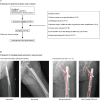Changes in nail position and antirotation blade angles on the risk of femoral head varus in PFNA fixed patients: a clinical review and comprehensive biomechanical research
- PMID: 38890700
- PMCID: PMC11186283
- DOI: 10.1186/s40001-024-01892-7
Changes in nail position and antirotation blade angles on the risk of femoral head varus in PFNA fixed patients: a clinical review and comprehensive biomechanical research
Abstract
Background: Femoral head varus triggers poor clinical prognosis in intertrochanteric fracture patients with proximal femoral nail antirotation (PFNA) fixation. Studies present that changes in nail position and screw insertion angles will affect fixation stability, but the biomechanical significance of these factors on the risk of femoral head varus has yet to be identified in PFNA fixed patients.
Methods: Clinical data in PFNA fixed intertrochanteric fracture patients have been reviewed, the relative position of intermedullary nail has been judged in the instant postoperative lateral radiography. Regression analyses have been performed to identify the effect of this factor on femoral head varus. Corresponding biomechanical mechanism has been identified by numerical mechanical simulations.
Results: A clinical review revealed that ventral side nail insertion can trigger higher risk of femoral head varus, corresponding numerical mechanical simulations also recorded poor fixation stability in models with ventral side nail insertion, and changes in the trajectory of anti-rotation blade will not obviously affect this tendency.
Conclusions: Ventral side insertion of intramedullary nail can trigger higher risk of femoral head varus in PFNA fixed patients by deteriorating the instant postoperative biomechanical environment, and changes in blade trajectory cannot change this tendency biomechanically. Therefore, this nail position should be adjusted to optimize patients' prognosis.
Keywords: Femoral head varus; Fixation stability; Intertrochanteric fracture; Intramedullary nail position changes; Proximal femoral nail anti-rotation.
© 2024. The Author(s).
Conflict of interest statement
The authors of this manuscript declare no relationships with any companies, whose products or services may be related to the subject matter of the article.
Figures





Similar articles
-
Larger nail-shaft gap as a potential risk factor of femoral head varus in patients treated with proximal femoral nail antirotation fixation: a retrospective, observational, single-center study with corresponding numerical simulation.Quant Imaging Med Surg. 2025 Jul 1;15(7):6032-6043. doi: 10.21037/qims-2024-2988. Epub 2025 Jun 30. Quant Imaging Med Surg. 2025. PMID: 40727332 Free PMC article.
-
Extending the intermedullary nail will not reduce the potential risk of femoral head varus in PFNA patients biomechanically: a clinical review and corresponding numerical simulation.BMC Musculoskelet Disord. 2024 May 23;25(1):405. doi: 10.1186/s12891-024-07334-z. BMC Musculoskelet Disord. 2024. PMID: 38783225 Free PMC article. Review.
-
Biomechanical study on the stability and strain conduction of intertrochanteric fracture fixed with proximal femoral nail antirotation versus triangular supporting intramedullary nail.Int Orthop. 2022 Feb;46(2):341-350. doi: 10.1007/s00264-021-05250-8. Epub 2021 Oct 26. Int Orthop. 2022. PMID: 34704144
-
Finite Element Analysis of Proximal Femoral Bionic Nail (PFBN), Proximal Femoral Nail Antirotation and InterTan for Treatment of Reverse Obliquity Intertrochanteric Fractures.Orthop Surg. 2025 Mar;17(3):888-899. doi: 10.1111/os.14345. Epub 2025 Jan 25. Orthop Surg. 2025. PMID: 39865505 Free PMC article.
-
Research Progress on the Treatment of Geriatric Intertrochanteric Femur Fractures with Proximal Femur Bionic Nails (PFBNs).Orthop Surg. 2024 Oct;16(10):2303-2310. doi: 10.1111/os.14134. Epub 2024 Jul 9. Orthop Surg. 2024. PMID: 38982572 Free PMC article. Review.
Cited by
-
Larger nail-shaft gap as a potential risk factor of femoral head varus in patients treated with proximal femoral nail antirotation fixation: a retrospective, observational, single-center study with corresponding numerical simulation.Quant Imaging Med Surg. 2025 Jul 1;15(7):6032-6043. doi: 10.21037/qims-2024-2988. Epub 2025 Jun 30. Quant Imaging Med Surg. 2025. PMID: 40727332 Free PMC article.
References
-
- Wei Z, Chen S, Zhang S. Research progress on anteromedial cortical positive support reduction in treatment of intertrochanteric fracture. Zhongguo xiu fu chong jian wai ke za zhi Zhongguo xiufu chongjian waike zazhi Chin J Reparative Reconstr Surg. 2019;33:1216–1222. doi: 10.7507/1002-1892.201904154. - DOI - PMC - PubMed
MeSH terms
LinkOut - more resources
Full Text Sources
Medical

